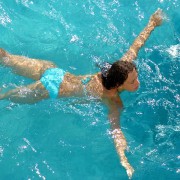My initial idea for part 2 of this degenerative disc disease article was to scare you into perfect posture and age-defying techniques. After deep reconstructive thought, I decided to put myself in my own shoes of ideas and test out what I was going to suggest to you. Over the past few weeks I practiced some preventative lifestyle changes and narrowed down which ones I truly believe are attainable and will make a difference in your present and/or future.
As a candidate for future back problems (thank you Kelly family genes) I really spent some time the past few weeks honing in on the typical back behaviors we practice without acknowledging the enormous pressure we put on our back on a daily basis. With that said, here are some small changes I believe you can make to ultimately put you and your spine in a better position for today, tomorrow and the future.
Firstly, I made all attempts to keep good posture throughout the day - not such an easy task, may I add. Considering I sit in an edit bay all day editing TV shows, my posture is bound to be horrific, and it was. I now understand why I walk away stiff and my feet fall asleep. Making a chair switch for one with a stiff back, and being semi-conscious of my effort to do so, made me feel significantly better than usual and more awake after a long day. Although my posture was not perfect 100% of the day, even making half the effort I did, put my spine in a much healthier position.
In addition, I went online and found a few light back and neck stretches to do in the morning and at the end of the day. While my coffee was brewing in the morning and American Idol was on at night I spent just five minutes breathing slow and deep, lightly stretching some tight areas in my spine, neck and down my legs. In just a few days, I felt an enormous amount of tension lifted off my back and it gave me time to relieve a little pre and post-work stress I have about the day.
Feeling down and out lately? Well research shows that degenerative disc disease can be linked to depression. So, if you feel yourself slumping down that road, before you feel compelled to see a therapist or get on an anti-depressant, consider something different - low impact aerobics. This has many benefits for your spine including coordination, strength and endurance, but above all, aides you away from anxiety and depression.
Another idea to consider - when you are lying in bed take a moment to notice the position your spine is in. Of course it is natural to find yourself in fetal position. That is essentially how we spent the first 9 months of our life in the womb. However, bending your back in that position for eight hours a night – especially at our age – is a totally different story. Even if I woke up in fetal position, I believe I get 10 points for effort for falling asleep with my back straight.
And last, but certainly not least, may I suggest a tactic that significantly changed my life in the course of just seven days?
Yoga.
I have grappled with the idea of yoga for some time now due to my stress level at work, my semi-rigorous exercise routine and the simple fact that I am 26-year old in a quarter-life crisis. But then again, who isn’t in some sort of crisis?
However, I always brushed the idea of yoga off and assumed it was too slow for my high strung personality and too expensive for my wallet. Well, two weeks ago I signed up for an “all you can yoga” week, and it certainly proved all my theories incorrect – and I am quite glad.
I tried all the yoga classes they offered: hot (bikrim) yoga, vinyasa and yoga power hour. Whoa, did I yoga. The most noteworthy lesson I have learned in class is to always work on stability before mobility. Because our lumbar spine is connected to our pelvis, it bears the most weight and stress of everyday body movements. When you improve your stability, your mobility and strength follows. The sometimes awkward positions you find yourself in yoga improve all three supporting the discs in your spine and your foundation – your legs. Stronger muscles add more support to your bones and joints to stay healthy and mobile.
If I was to take a balance test before I walked into class, one would assume I was a 1 year old learning to walk on my own two feet. Two weeks and six yoga classes later, I am ready to sign up for the tight rope walk – or close to it. But, because I left my reservations at the door when I entered the studio, I was able free myself of assumption and learn to breathe through my body movements, allowing me to balance, stretch and strengthen not only my back, but my body as a whole. And to add to sugar to a sugar cookie, I mentally feel on top of the world.
It is small adjustments that any person with any back condition can and should incorporate in their daily lives. I know for a fact, with just two weeks of minor tweaking I feel lighter and more flexible. And I know for a fact if my lower back could talk, it would say thank you, thank you, thank you.
So, if you find yourself in a genetics/age pickle for degenerative disc disease, please do yourself a favor and try one or all of these ideas. Take control of your body and degenerative disc disease before it takes control of you.




Add a CommentComments
There are no comments yet. Be the first one and get the conversation started!